Examining Spatial Variation in the Effects of Japanese Red Pine (Pinus densiflora) on Burn Severity Using Geographically Weighted Regression
Abstract
:1. Introduction
2. Methods and Data
2.1. Samcheok Fire and Site Characteristics
2.2. Analysis Spatial Unit
2.3. Computing the Percentage of Japanese Red Pine and Topographic Characteristics
2.4. Mapping Burn Severity
2.5. Estimating the Global (OLS) and Local (GWR) Models
2.6. Estimation and Comparison of the Regression Models
3. Results
3.1. Spatial Distribution of Burn Severity and Percentage of Japanese Red Pine
3.2. Relationships of Burn Severity with Japanese Red Pine and Topographic Variables
3.3. Comparison of the Estimated OLS and GWR Models
3.4. Spatial Variation in the Non-Stationary Effects of Japanese Red Pine
3.5. Topographic Characteristics and Parameters of the Estimated GWR Model
4. Discussion
5. Conclusions
Acknowledgments
Author Contributions
Conflicts of Interest
References
- Bonnet, V.H.; Schoettle, A.W.; Shepperd, W.D. Postfire environmental conditions influence the spatial pattern of regeneration for Pinus ponderosa. Can. J. For. Res. 2005, 35, 37–47. [Google Scholar] [CrossRef]
- Crotteau, J.S.; Varner, J.M.; Ritchie, M.W. Post-fire regeneration across a fire severity gradient in the southern cascades. For. Ecol. Manag. 2013, 287, 103–112. [Google Scholar] [CrossRef]
- Johnson, E.A. Fire and Vegetation Dynamics: Studies from the North American Boreal Forest; Cambridge University Press: Cambridge, UK, 1996. [Google Scholar]
- Ordóñez, J.L.; Retana, J.; Espelta, J.M. Effects of tree size, crown damage, and tree location on post-fire survival and cone production of Pinus nigra trees. For. Ecol. Manag. 2005, 206, 109–117. [Google Scholar] [CrossRef]
- Retana, J.; Maria Espelta, J.; Habrouk, A.; Luis OrdoÑEz, J.; de Solà-Morales, F. Regeneration patterns of three Mediterranean pines and forest changes after a large wildfire in northeastern Spain. Ecoscience 2002, 9, 89–97. [Google Scholar] [CrossRef]
- Turner, M.G.; Romme, W.H.; Gardner, R.H. Prefire heterogeneity, fire severity, and early postfire plant reestablishment in subalpine forests of Yellowstone national park, Wyoming. Int. J. Wildland Fire 2000, 9, 21–36. [Google Scholar] [CrossRef]
- Brown, J.K. Ecological principles, shifting fire regimes and management considerations. In Wildland Fire in Ecosystems: Effects of Fire on Flora; Brown, J.K., Smith, J.K., Eds.; RMRS-GTR-42-vol. 2; US Department of Agriculture Forest Service, Rocky Mountain Research Station: Ogden, UT, USA, 2000. [Google Scholar]
- Benavides-Solorio, J.D.; MacDonald, L.H. Measurement and prediction of post-fire erosion at the hillslope scale, colorado front range. Int. J. Wildland Fire 2005, 14, 457–474. [Google Scholar] [CrossRef]
- Cawson, J.; Sheridan, G.; Smith, H.; Lane, P. Effects of fire severity and burn patchiness on hillslope-scale surface runoff, erosion and hydrologic connectivity in a prescribed burn. For. Ecol. Manag. 2013, 310, 219–233. [Google Scholar] [CrossRef]
- Ferreira, A.; Coelho, C.D.O.; Ritsema, C.; Boulet, A.; Keizer, J. Soil and water degradation processes in burned areas: Lessons learned from a nested approach. Catena 2008, 74, 273–285. [Google Scholar] [CrossRef]
- Wan, S.; Hui, D.; Luo, Y. Fire effects on nitrogen pools and dynamics in terrestrial ecosystems: A meta-analysis. Ecol. Appl. 2001, 11, 1349–1365. [Google Scholar] [CrossRef]
- Certini, G. Effects of fire on properties of forest soils: A review. Oecologia 2005, 143, 1–10. [Google Scholar] [CrossRef] [PubMed]
- MacDonald, L.H.; Huffman, E.L. Post-fire soil water repellency. Soil Sci. Soc. Am. 2004, 68, 1729–1734. [Google Scholar] [CrossRef]
- Fontaine, J.B.; Kennedy, P.L. Meta-analysis of avian and small-mammal response to fire severity and fire surrogate treatments in us fire-prone forests. Ecol. Appl. 2012, 22, 1547–1561. [Google Scholar] [CrossRef] [PubMed]
- Roberts, S.; Van Wagtendonk, J.; Miles, A.; Kelt, D.; Lutz, J. Modeling the effects of fire severity and spatial complexity on small mammals in Yosemite national park, California. Fire. Ecol. 2008, 4, 83–104. [Google Scholar] [CrossRef]
- Smucker, K.M.; Hutto, R.L.; Steele, B.M. Changes in bird abundance after wildfire: Importance of fire severity and time since fire. Ecol. Appl. 2005, 15, 1535–1549. [Google Scholar] [CrossRef]
- Johnstone, J.F.; Chapin, F.S. Effects of soil burn severity on post-fire tree recruitment in boreal forest. Ecosystems 2006, 9, 14–31. [Google Scholar] [CrossRef]
- Knapp, E.E.; Estes, B.L.; Skinner, C.N. Ecological Effects of Prescribed Fire Season: A Literature Review and Synthesis for Managers; General Technical Report PSW-GTR-224; USDA Forest Service: Albany, CA, USA, 2009; p. 80. [Google Scholar]
- Lee, S.-W.; Lee, M.-B.; Lee, Y.-G.; Won, M.-S.; Kim, J.-J.; Hong, S.-K. Relationship between landscape structure and burn severity at the landscape and class levels in Samchuck, South Korea. For. Ecol. Manag. 2009, 258, 1594–1604. [Google Scholar] [CrossRef]
- Dillon, G.K.; Holden, Z.A.; Morgan, P.; Crimmins, M.A.; Heyerdahl, E.K.; Luce, C.H. Both topography and climate affected forest and woodland burn severity in two regions of the western us, 1984 to 2006. Ecosphere 2011, 2, 1–33. [Google Scholar] [CrossRef]
- Lecina-Diaz, J.; Alvarez, A.; Retana, J. Extreme fire severity patterns in topographic, convective and wind-driven historical wildfires of mediterranean pine forests. PLoS ONE 2014, 9, e85127. [Google Scholar] [CrossRef] [PubMed]
- Holden, Z.A.; Morgan, P.; Evans, J.S. A predictive model of burn severity based on 20-year satellite-inferred burn severity data in a large southwestern us wilderness area. For. Ecol. Manag. 2009, 258, 2399–2406. [Google Scholar] [CrossRef]
- Bigler, C.; Kulakowski, D.; Veblen, T.T. Multiple disturbance interactions and drought influence fire severity in rocky mountain subalpine forests. Ecology 2005, 86, 3018–3029. [Google Scholar] [CrossRef]
- Birch, D.S.; Morgan, P.; Kolden, C.A.; Abatzoglou, J.T.; Dillon, G.K.; Hudak, A.T.; Smith, A. Vegetation, topography and daily weather influenced burn severity in central Idaho and western Montana forests. Ecosphere 2015, 6, 1–23. [Google Scholar] [CrossRef]
- Cruz, M.G.; Butler, B.W.; Alexander, M.E. Predicting the ignition of crown fuels above a spreading surface fire. Part ii: Model evaluation. Int. J. Wildland Fire 2006, 15, 61–72. [Google Scholar] [CrossRef]
- Sikkink, P.G.; Keane, R.E. Predicting Fire Severity Using Surface Fuels and Moisture; Research Paper RMRS-RP-96; USDA Forest Service, Rocky Mountain Research Station: Fort Collins, CO, USA, 2012; p. 37. [Google Scholar]
- Amato, V.J.; Lightfoot, D.; Stropki, C.; Pease, M. Relationships between tree stand density and burn severity as measured by the composite burn index following a ponderosa pine forest wildfire in the American Southwest. For. Ecol. Manag. 2013, 302, 71–84. [Google Scholar] [CrossRef]
- Viedma, O.; Quesada, J.; Torres, I.; De Santis, A.; Moreno, J.M. Fire severity in a large fire in a Pinus pinaster forest is highly predictable from burning conditions, stand structure, and topography. Ecosystems 2015, 18, 237–250. [Google Scholar] [CrossRef]
- Alvarez, A.; Gracia, M.; Vayreda, J.; Retana, J. Patterns of fuel types and crown fire potential in Pinus halepensis forests in the western Mediterranean basin. For. Ecol. Manag. 2012, 270, 282–290. [Google Scholar] [CrossRef]
- Broncano, M.J.; Retana, J. Topography and forest composition affecting the variability in fire severity and post-fire regeneration occurring after a large fire in the Mediterranean basin. Int. J. Wildland Fire 2004, 13, 209–216. [Google Scholar] [CrossRef]
- Carlson, D.J.; Reich, P.B.; Frelich, L.E. Fine-scale heterogeneity in overstory composition contributes to heterogeneity of wildfire severity in southern boreal forest. J. For. Res. 2011, 16, 203–214. [Google Scholar] [CrossRef]
- Fernandes, P.M.; Luz, A.; Loureiro, C. Changes in wildfire severity from maritime pine woodland to contiguous forest types in the mountains of northwestern Portugal. For. Ecol. Manag. 2010, 260, 883–892. [Google Scholar] [CrossRef]
- Lentile, L.B.; Smith, F.W.; Shepperd, W.D. Influence of topography and forest structure on patterns of mixed severity fire in ponderosa pine forests of the South Dakota black hills, USA. Int. J. Wildland Fire 2006, 15, 557–566. [Google Scholar] [CrossRef]
- Scott, J.H.; Reinhardt, E.D. Assessing Crown Fire Potential by Linking Models of Surface and Crown Fire Behavior; Research Paper RMRS-RP-29; Department of Agriculture, Forest Service, Rocky Mountain Research Station: Fort Collins, CO, USA, 2001; p. 59. [Google Scholar]
- Brunsdon, C.; Fotheringham, A.S.; Charlton, M.E. Geographically Weighted Regression: A method for exploring spatial nonstationarity. Geogr. Anal. 1996, 28, 281–298. [Google Scholar] [CrossRef]
- Fotheringham, A.S.; Brunsdon, C.; Charlton, M. Geographically Weighted Regression: The Analysis of Spatially Varying Relationships; John Wiley & Sons: West Sussex, UK, 2003. [Google Scholar]
- An, K.-J.; Lee, S.-W.; Hwang, S.-J.; Park, S.-R.; Hwang, S.-A. Exploring the non-stationary effects of forests and developed land within watersheds on biological indicators of streams using geographically-weighted regression. Water 2016, 8, 120. [Google Scholar] [CrossRef]
- Tu, J. Spatially varying relationships between land use and water quality across an urbanization gradient explored by geographically weighted regression. Appl. Geogr. 2011, 31, 376–392. [Google Scholar] [CrossRef]
- Propastin, P.; Ibrom, A.; Knohl, A.; Erasmi, S. Effects of canopy photosynthesis saturation on the estimation of gross primary productivity from Modis data in a tropical forest. Remote Sens. Environ. 2012, 121, 252–260. [Google Scholar] [CrossRef]
- Lu, B.; Charlton, M.; Fotheringhama, A.S. Geographically weighted regression using a non-Euclidean distance metric with a study on London house price data. Procedia Environ. Sci. 2011, 7, 92–97. [Google Scholar] [CrossRef]
- Saphores, J.-D.; Li, W. Estimating the value of urban green areas: A hedonic pricing analysis of the single family housing market in Los Angeles, CA. Landsc. Urban Plan. 2012, 104, 373–387. [Google Scholar] [CrossRef]
- Kamarianakis, Y.; Shen, W.; Wynter, L. Real-time road traffic forecasting using regime-switching space-time models and adaptive lasso. Appl. Stoch. Models Bus. Ind. 2012, 28, 297–315. [Google Scholar] [CrossRef]
- Szymanowski, M.; Kryza, M. Application of geographically weighted regression for modelling the spatial structure of urban heat island in the city of Wroclaw (SW Poland). Procedia Environ. Sci. 2011, 3, 87–92. [Google Scholar] [CrossRef]
- Nunes, A.; Lourenço, L.; Meira, A.C. Exploring spatial patterns and drivers of forest fires in Portugal (1980–2014). Sci. Total Environ. 2016, 573, 1190–1202. [Google Scholar] [CrossRef] [PubMed]
- Rodrigues, M.; de la Riva, J.; Fotheringham, S. Modeling the spatial variation of the explanatory factors of human-caused wildfires in Spain using geographically weighted logistic regression. Appl. Geogr. 2014, 48, 52–63. [Google Scholar] [CrossRef]
- Martínez-Fernández, J.; Chuvieco, E.; Koutsias, N. Modelling long-term fire occurrence factors in Spain by accounting for local variations with geographically weighted regression. Nat. Hazards Earth Syst. 2013, 13, 311. [Google Scholar] [CrossRef]
- Oliveira, S.; Pereira, J.M.; San-Miguel-Ayanz, J.; Lourenço, L. Exploring the spatial patterns of fire density in southern Europe using geographically weighted regression. Appl. Geogr. 2014, 51, 143–157. [Google Scholar] [CrossRef]
- Korea Forest Service. Fires in Eastern Regions; Korea Forest Service: Daejoen, Korea, 2001; Volume 1, pp. 33–36. [Google Scholar]
- Lloret, F.; Calvo, E.; Pons, X.; Díaz-Delgado, R. Wildfires and landscape patterns in the eastern Iberian peninsula. Landsc. Ecol. 2002, 17, 745–759. [Google Scholar] [CrossRef]
- Gralewicz, N.J.; Nelson, T.A.; Wulder, M.A. Factors influencing national scale wildfire susceptibility in canada. For. Ecol. Manag. 2012, 265, 20–29. [Google Scholar] [CrossRef]
- Lee, S.-W.; Won, M.-S.; Lee, J.-M.; Kim, H.-G. Intermediate-scale analysis of landscape characteristics affecting edge formation in burned forests in Samcheok, Korea. J. Mt. Sci. 2014, 11, 384–397. [Google Scholar] [CrossRef]
- Autodesk. 2016. Available online: http://www.autodesk.com/products/autocad/overview (accessed on 4 October 2016).
- ESRI ArcGIS Model Builder. 2016. Available online: http://resources.arcgis.com/en/help/main/10.1/index.html#//002w00000001000000 (accessed on 4 October 2016).
- Key, C.; Benson, N. Fire Effects Monitoring and Inventory Protocol—Landscape Assessment; USDA Forest Service Fire Science Laboratory: Missoula, MT, USA, 2002; pp. 1–16. [Google Scholar]
- Morgan, P.; Hardy, C.C.; Swetnam, T.W.; Rollins, M.G.; Long, D.G. Mapping fire regimes across time and space: Understanding coarse and fine-scale fire patterns. Int. J. Wildland Fire 2001, 10, 329–342. [Google Scholar] [CrossRef]
- Miller, J.D.; Yool, S.R. Mapping forest post-fire canopy consumption in several overstory types using multi-temporal landsat TM and ETM data. Remote Sens. Environ. 2002, 82, 481–496. [Google Scholar] [CrossRef]
- White, J.D.; Ryan, K.C.; Key, C.C.; Running, S.W. Remote sensing of forest fire severity and vegetation recovery. Int. J. Wildland Fire 1996, 6, 125–136. [Google Scholar] [CrossRef]
- Wimberly, M.C.; Reilly, M.J. Assessment of fire severity and species diversity in the southern Appalachians using Landsat tm and ETM+ imagery. Remote Sens. Environ. 2007, 108, 189–197. [Google Scholar] [CrossRef]
- Cocke, A.E.; Fulé, P.Z.; Crouse, J.E. Comparison of burn severity assessments using differenced normalized burn ratio and ground data. Int. J. Wildland Fire 2005, 14, 189–198. [Google Scholar] [CrossRef]
- Collins, B.M.; Kelly, M.; van Wagtendonk, J.W.; Stephens, S.L. Spatial patterns of large natural fires in Sierra Nevada wilderness areas. Landsc. Ecol. 2007, 22, 545–557. [Google Scholar] [CrossRef]
- Epting, J.; Verbyla, D.; Sorbel, B. Evaluation of remotely sensed indices for assessing burn severity in interior Alaska using Landsat tm and ETM+. Remote Sens. Environ. 2005, 96, 328–339. [Google Scholar] [CrossRef]
- Roy, D.P.; Boschetti, L.; Trigg, S.N. Remote sensing of fire severity: Assessing the performance of the normalized burn ratio. IEEE Geosci. Remote Sens. Lett. 2006, 3, 112–116. [Google Scholar] [CrossRef]
- Remote Sensing Application Center (RSAC). Burned Area Emergency Response (BAER) Imagery Support; Department of Agriculture Forest Service, Remote Sensing Applications Center: Salt Lake City, UT, USA, 2005; Available online: http://www.fs.fed.us/eng/rsac/baer/ (accessed on 4 October 2016).
- Brunsdon, C.; Fotheringham, S.; Charlton, M. Geographically Weighted Regression. J. R. Stat. Soc. Ser. D Stat. 1998, 47, 431–443. [Google Scholar] [CrossRef]
- Fotheringham, A.S. Quantification, evidence and positivism. In Approaches to Human Geography; Aitken, S., Valentine, G., Eds.; SAGE Publications: Thousand Oaks, CA, USA, 2006; pp. 237–250. [Google Scholar]
- Fortin, M.-J.; Drapeau, P.; Legendre, P. Spatial autocorrelation and sampling design in plant ecology. Vegetatio 1989, 83, 209–222. [Google Scholar] [CrossRef]
- Lee, B.; Won, M.S.; Lee, Y.; Lee, M.B. Crown fuel characteristics and carbon emission from Japanese red pine stands burned by crown fire in Mt. Palgong, South Korea. J. Mt. Sci. 2012, 9, 656–664. [Google Scholar] [CrossRef]
- Hare, R.C. Contribution of bark to fire resistance of southern trees. J. For. 1965, 63, 248–251. [Google Scholar]
- Hengst, G.E.; Dawson, J.O. Bark properties and fire resistance of selected tree species from the central hardwood region of North America. Can. J. For. Res. 1994, 24, 688–696. [Google Scholar] [CrossRef]
- Pinard, M.A.; Huffman, J. Fire resistance and bark properties of trees in a seasonally dry forest in eastern Bolivia. J. Trop. Ecol. 1997, 13, 727–740. [Google Scholar] [CrossRef]
- Agee, J.K. Fire and Weather Disturbances in Terrestrial Ecosystems of the Eastern Cascades; General Technical Report PNW-GTR-320; USDA Forest Service Pacific Northwest Research Station: Portland, OR, USA, 1994; p. 52. [Google Scholar]
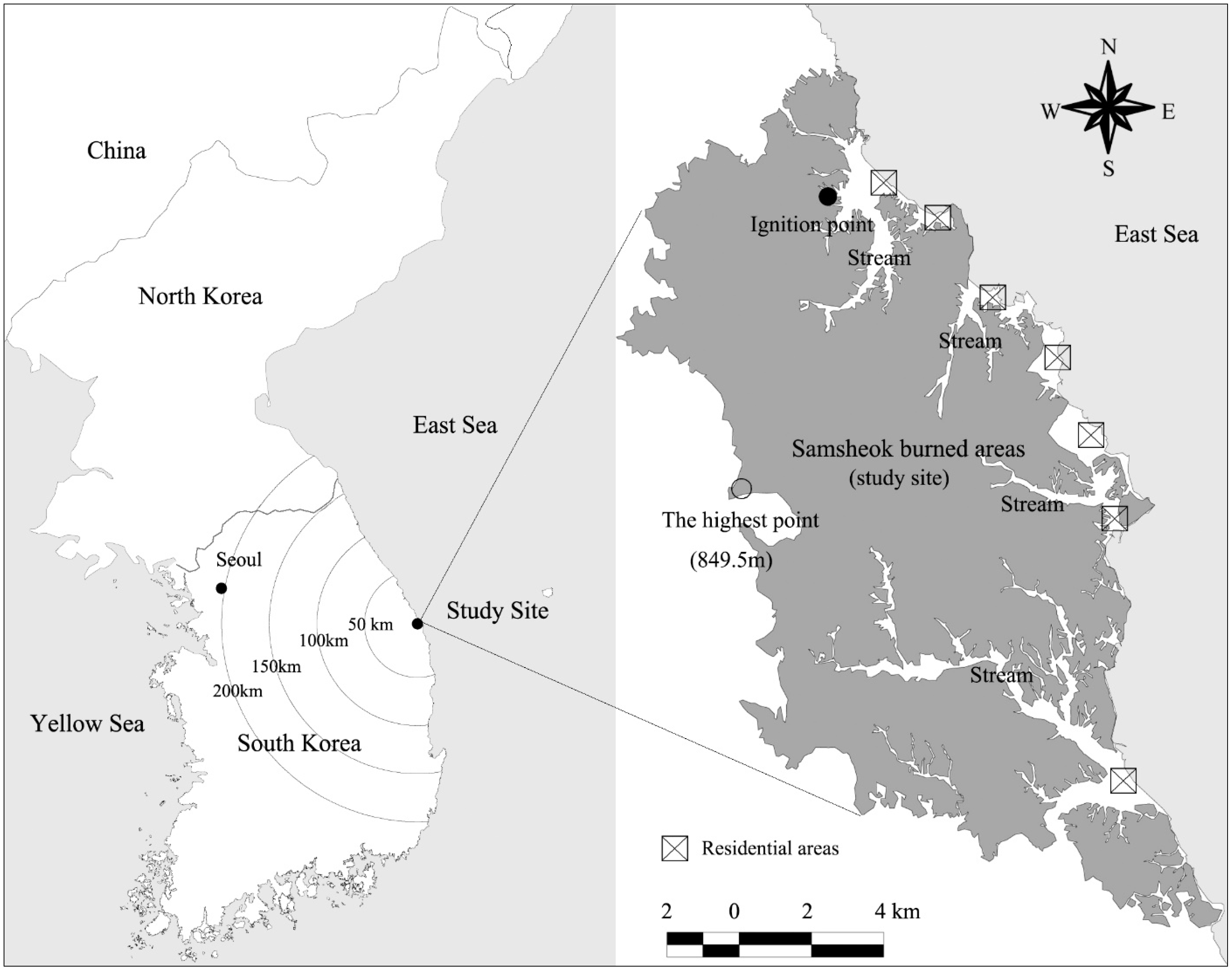
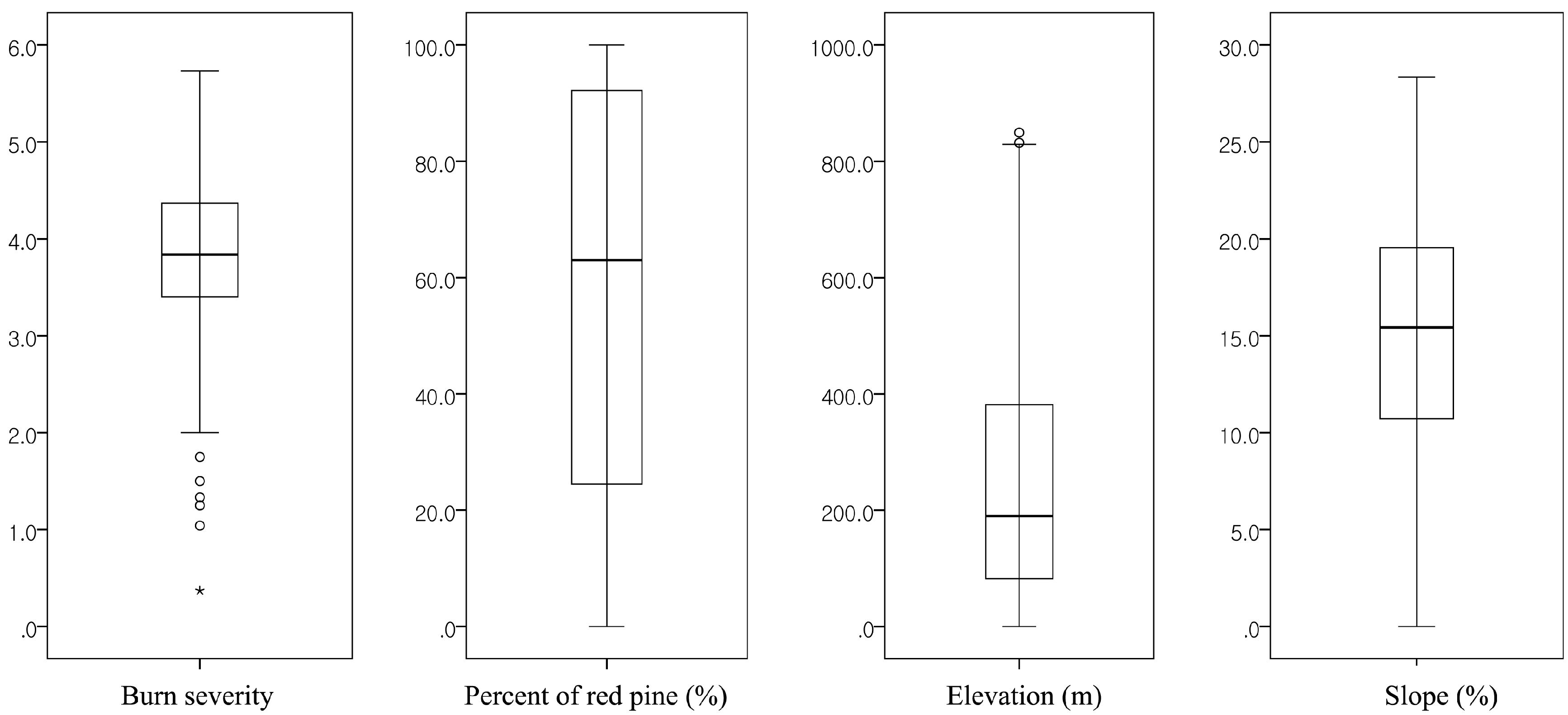
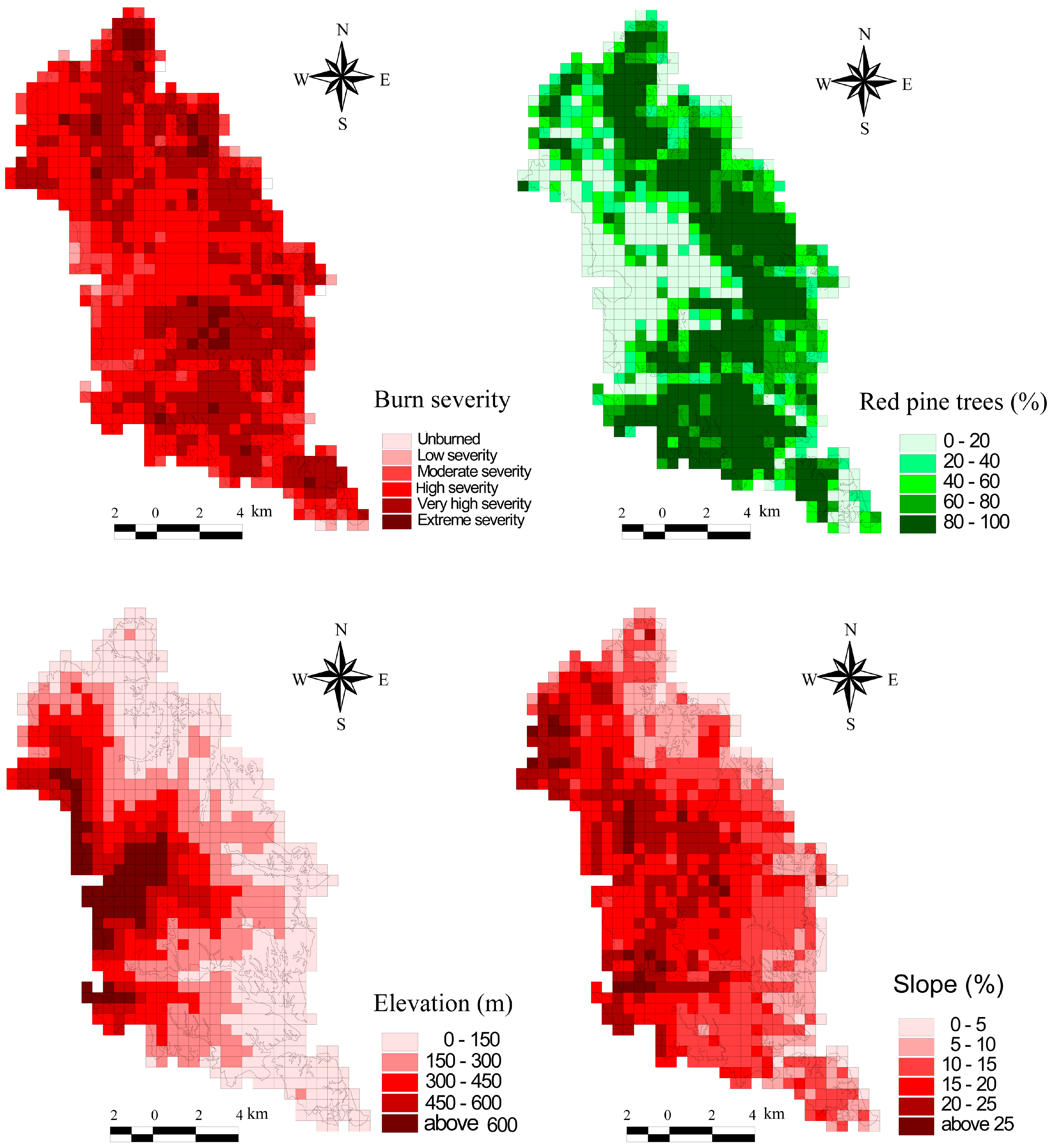

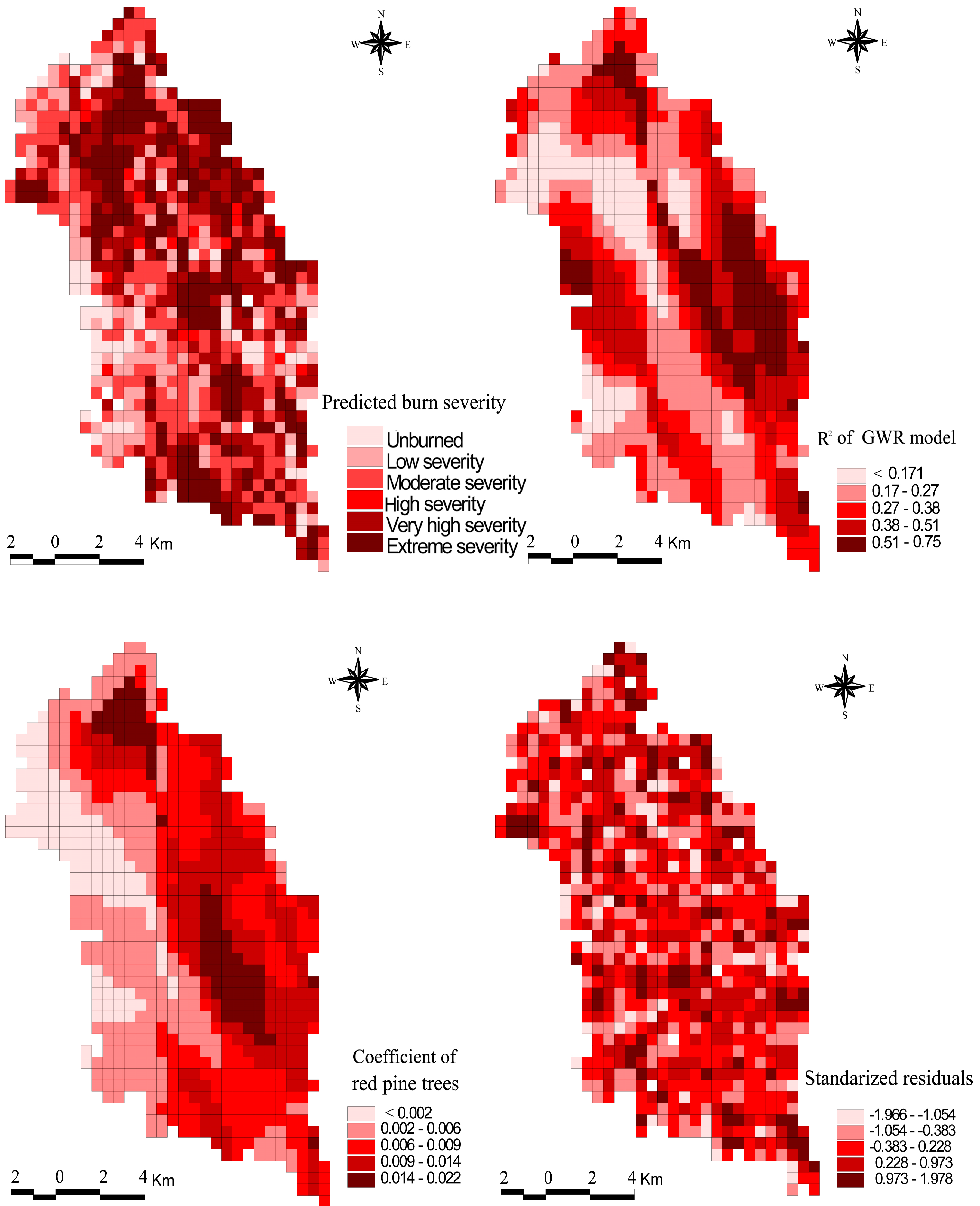
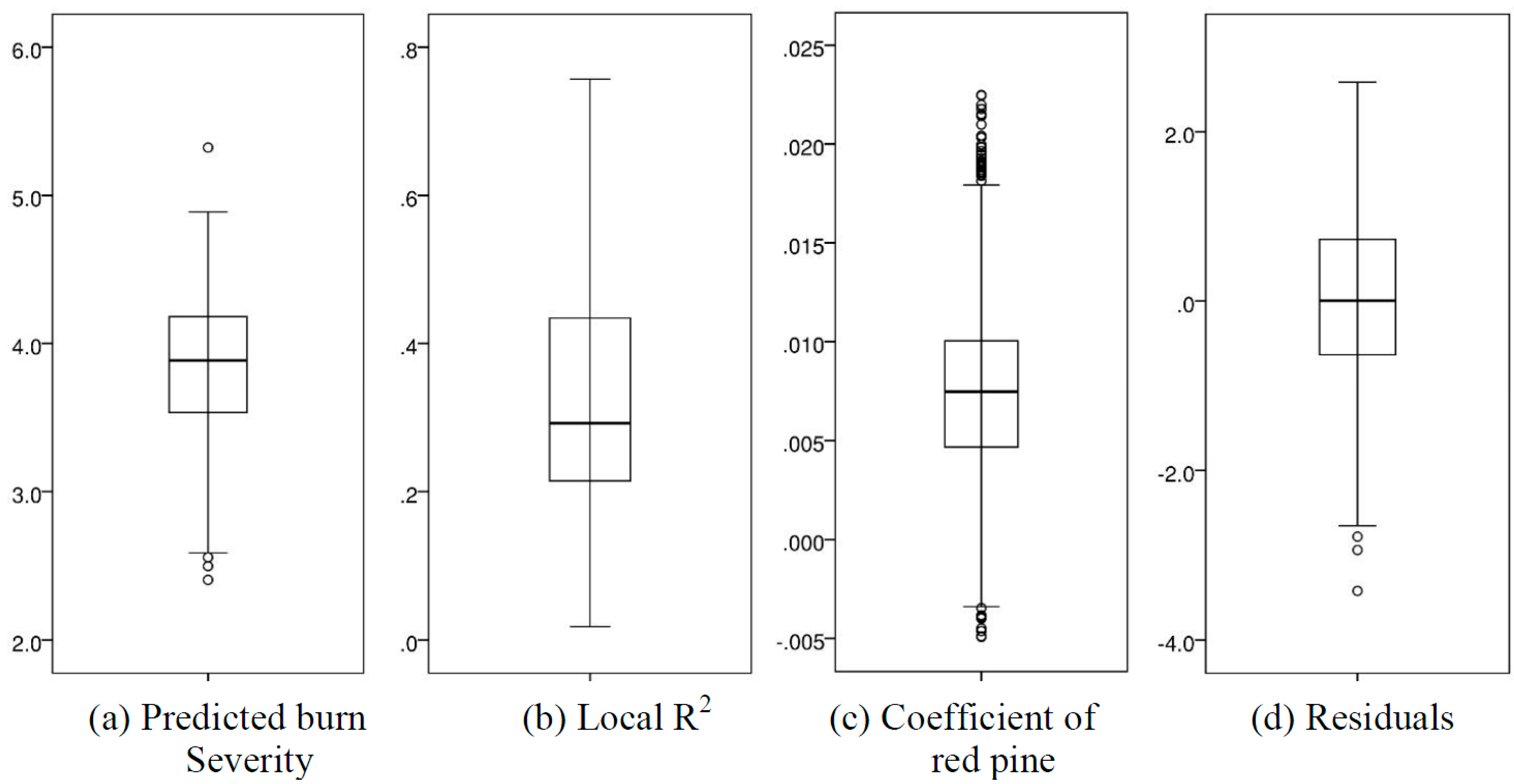
| Red Pine Trees (%) | Slope (%) | Elevation (m) | |
|---|---|---|---|
| Burn severity | 0.48 ** | 0.01 | −0.22 ** |
| Red pine trees (%) | −0.08 * | −0.41 ** | |
| Slope (%) | 0.69 ** |
| Variable | OLS Model (Global Model) | GWR Model 1 (Local Model) | ||
|---|---|---|---|---|
| b | β | t-Value | ||
| Intercept | 3.22 | - | 48.87 ** | - |
| Red pine (%) | 0.009 | 0.48 | 13.97 ** | - |
| Slope (%) | 0.015 | 0.14 | 3.09 * | - |
| Elevation (m) | 0.001 | −0.12 | −2.59 ** | |
| F-value | 103.36 ** | |||
| Adjusted R2 | 0.28 | 0.57 | ||
| AICc | 1330.45 | 950.46 | ||
| Moran’s I 2 | 0.5 | 0.28 | ||
| Topographic Characteristics | Estimated GWR Model | ||||
|---|---|---|---|---|---|
| R2 | Intercept | C_Pine | C_Elevation | C_Slope | |
| Elevation (m) | −0.12 | 0.32 ** | −0.45 ** | −0.45 ** | 0.21 * |
| Slope (%) | −0.21 | 0.21 * | −0.37 ** | −0.28 ** | 0.12 |
| Elevation Group | F-Value | Adjusted-R2 | Coefficients (β-Value) | ||
|---|---|---|---|---|---|
| Red Pine Trees | Slope | Elevation | |||
| Group 1 | 36.98 ** | 0.36 | 0.02 ** | 0.007 | 0.001 |
| −0.56 | −0.04 | −0.03 | |||
| Group 2 | 6.72 ** | 0.08 | 0.008 ** | −0.028 * | 0.001 |
| −0.27 | (−0.16) | −0.07 | |||
| Group 3 | 10.74 ** | 0.13 | 0.004 ** | −0.041 ** | 0.002 ** |
| −0.23 | (−0.26) | −0.19 | |||
| Group 4 | 34.22 ** | 0.34 | 0.004 ** | −0.017 | −0.003 ** |
| −0.19 | (−0.08) | (−0.52) | |||
© 2017 by the authors. Licensee MDPI, Basel, Switzerland. This article is an open access article distributed under the terms and conditions of the Creative Commons Attribution (CC BY) license (http://creativecommons.org/licenses/by/4.0/).
Share and Cite
Lee, H.-J.; Kim, E.-J.; Lee, S.-W. Examining Spatial Variation in the Effects of Japanese Red Pine (Pinus densiflora) on Burn Severity Using Geographically Weighted Regression. Sustainability 2017, 9, 804. https://doi.org/10.3390/su9050804
Lee H-J, Kim E-J, Lee S-W. Examining Spatial Variation in the Effects of Japanese Red Pine (Pinus densiflora) on Burn Severity Using Geographically Weighted Regression. Sustainability. 2017; 9(5):804. https://doi.org/10.3390/su9050804
Chicago/Turabian StyleLee, Hyun-Joo, Eujin-Julia Kim, and Sang-Woo Lee. 2017. "Examining Spatial Variation in the Effects of Japanese Red Pine (Pinus densiflora) on Burn Severity Using Geographically Weighted Regression" Sustainability 9, no. 5: 804. https://doi.org/10.3390/su9050804





